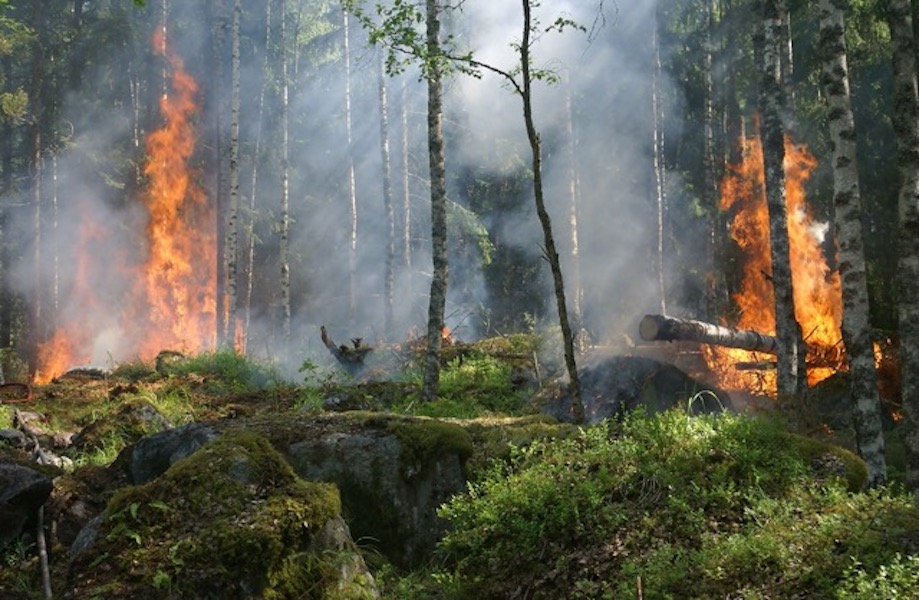“Our city is ashes. Three thousand people homeless. Can you send any government aid?”
These were the urgent words of Vancouver Mayor Malcolm McLean, dispatched in an emergency telegram to the federal government on June 14, 1886.
Hours earlier, a wildfire had been sparked on the outskirts of the Westend Forest before blazing a path of destruction through the streets of Vancouver. With the city in flames, refugees gathered on the south shore of false creek, anxiously awaiting aid from neighbouring towns. The supply wagons eventually did arrive, and the work of rebuilding the city slowly began.
From those ashes, Vancouver has grown into a vibrant, globally influential city, but with development and modernity has come a sense of distance between city dwellers and the risks presented by fire. The 2017 wildfire season, however, challenged that perception.
Between July and September, fire burned over 1.2 million hectares of land in British Columbia. Thick smoke blanketed the downtown Vancouver skyline, obscured the surrounding mountain vistas, and served as a daily reminder of the destruction that was taking place beyond the Lower Mainland. Across the province of BC, nearly 65,000 people were displaced from their communities by fires during those hot summer months.
We will almost certainly learn of new fires in 2018, yet not every one of those flare-ups prompts an immediate call to the Martin Mars water bomber and firefighting crews. Most fires burn out within a few hundred meters from their point of origin. A very limited number of fires, as few as 2%-3%, do break out more widely, but those are the dangerous ones, accounting for up to 97% of the area burned.
“A relatively small amount of fires are responsible for most of the impact, and a lot of these happen on a few critical days of severe fire weather,” explained Dr. Mike Flannigan, professor with the Department of Renewable Resources at the University of Alberta and the Director of the Western Partnership for Wildland Fire Science.
As such, understanding the potential of a small fire to grow into a big one, and allocating fire suppression resources accordingly, is an area where science can play an important role. There are three factors that contribute to a fire: fuel, ignition, and weather.
Fuels consist of combustible materials, such as trees and grass. Dry fuels burn more quickly, and while many will point to a heavy winter snowpack as being a safeguard against summer fires, the moisture of the spring runoff can dissipate very quickly.
“Those fuels can dry out in a few days,” commented Dr. Flannigan. “A few days of hot windy weather in the forest changes everything. I don’t care how much it rained before or how much snow we have in the winter, 3-5 hot, windy days and the forest can burn.”
Ignition refers to the means by which a fire is sparked.
“There are two ignition causes for fires in Canada, lightning and people,” said Dr. Flannigan. “About 40% of fires are started by lightning and 60% by people.”
Human-related ignition is often preventable, including sparks from campfires or discarded cigarettes. Lightning is almost as problematic, with summer storms able to draw in more water vapour, grow quickly in intensity, and develop the potential for electrical discharge.
Weather is the third factor that contributes to wildfires, and is perhaps the most important determinant of their duration and intensity. In addition to drying out the underbrush and generating lightning – hot, windy and arid summer conditions can quickly transform a small local conflagration into a raging inferno. Weather is also the area where scientists can best apply the latest research, insights, models and predictive techniques to help inform fire suppression management and resource deployment.
Extreme weather patterns are central to Dr. Flannigan’s research. Using machine learning and self-organized maps, his research team is able to look at pressure patterns in the surface and mid-upper atmosphere in order to predict where the extreme fire weather situations are most likely to occur.
“What happens in the upper atmosphere really dictates what the surface weather will be,” said Dr. Flannigan. “It is arguable that climate change causes changes in the jet streams which impact where the low and high-pressure systems will be.”
Those low and high-pressure systems have a direct impact on precipitation patterns.
The research team believes they can improve on the previous generation of forecasting tools by inputting surface temperature, wind speed, humidity and precipitation into computer models that will be used to build a forest fire early warning system.
Such a model will not predict when and where a fire could break out, but would rather help to identify high-risk weather conditions. This type of early warning would help fire management departments to organize resources more effectively, helping to ensure that personnel and tools are deployed to contain the riskiest fires before they spread.
B.C. has roughly 1,100 of its own firefighters, but when additional resources are required, the contract-community is called upon. These private companies can supply about 2,500 additional personnel to help. Out-of-province assistance can also be coordinated through the Canadian Interagency Forest Fire Centre (CIFFC), and further assistance can be enlisted from other countries. Depending on where the firefighting crews and assets are coming from, deployment can take days, which is why knowing where the problem fires are most likely to occur would make a big impact.
“In B.C. our fire management approach is triaged,” noted Ryan Turcot, Information Officer for the BC Wildfire Services. “There are some wildfires that we give our full response to in order to contain it as quickly as possible, but not all wildfires need to be fought. In fact, you see this a lot in northern BC, in more remote areas, wildfires are actually a natural part of the ecosystem. If a wildfire in remote areas and does not pose any threat to people and property, we often apply a modified response, we still send personnel to monitor the fire and ensure it isn’t posing a threat but we do not contain it the same way.”
Turcot also added how small teams are deployed to monitor and contain fires before they become large. “When new smaller fires break out, we will send out an initial 3-person attack crew, and they are designed to sustain themselves without having to restock on resources for up to 24 hours,” said Turcot. Another type of crew is designed to restock themselves only after 72 hours. These are the type of crews we would send out after the initial attack size has surpassed, once we need more help.”
Factors that make the B.C. Wildfire Services decide on which crew to send depends on the size of the fire and how fast it is spreading, the proximity to infrastructure and conditions in the area. Another factor to consider is local fire history; recently burnt areas of the forest are unlikely to burn again for 15-20 years, which creates a natural firebreak. Thus, allowing smaller fire on the landscape can help to reduce the intensity of future fires.
Fires management equally considers the variability and rate of spread. Fires at ground level can be combatted, but become more dangerous as they rise in height. Crown fires, a dramatic form of fire that we witnessed in BC last summer, begin at the surface and get carried up to the tops of trees. As the flames race higher, they consume ladder fuels, which helps to take the fire to the top of the canopy. Once a crown fire is spreading, there is very little that fire management crews can do to stop them. Another type of dangerous fire is caused by hot, dry, windy conditions. These fast-moving fires can be too dangerous to fight by ground or by air.
One tactic available in certain cases is to initiate a burn intentionally. “Wind conditions have to be right, but if you can get in front of it and light a new fire that is backing into the wind, with an intensity that you can control, then when the wildfire reaches that burned out area, it runs out of fuel,” explained Dr. Flannigan.
2018 fire season
“There are variables you cannot forecast this far out,” noted Turcot, “but what we do know is that in the late spring we can expect temperatures that are normal to slightly above average temperature. And moving ahead into summer we expect above average temperatures. We always like to say, we will have a better idea once the June rains hit.”
The amount of precipitation observed in late spring tells us how dry the soil is going to be, with heavy spring rains likely leading to a less intense fire season during the hotter months of July and August. It is more challenging to anticipate ignition sources, as short-term forecasts can only give a limited indication of potential lightning storms, and of course, ignition from people is unpredictable.
With so many variables to consider, the risk to the community has to be mitigated as best as is possible. This is where the Canadian Fire Smart program plays a role. The program’s mission is to prepare communities for the threat of wildfires.
The most important area to manage is the Wildland-Urban Interface, which describes the intersection where forested areas and settlements meet. It is the thoughtful management of this area that can reduce the damage experienced by communities like Vancouver in 1886 or Williams Lake in 2017.
Fire Smart has seven principles they rely on education, vegetation management, legislation and planning, development considerations, interagency cooperation, emergency planning, and cross training. For example, on a practical level, the B.C. Wildfire services promote Fire Smart’s advice to the public on a few simple tips.
“People need to memorize wildfire reporting hotline, *5555 on their cellphone” commented Turcot. “They should also know and adhere to fire restrictions, which can be found on bcwildfire.ca. Campfires ashes have to be cool to the touch, cigarettes butts should be disposed of properly, and with ATVs, riders should be mindful of where they drive, as the exhaust system can spark wildfires, especially in tall dry grassy areas.”











